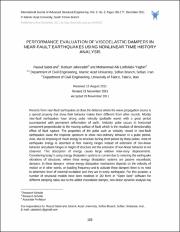Evaluation of the Performance of Visco-elastic Dampers in Near-fault Earthquakes using Nonlinear Time-history Analysis
(ندگان)پدیدآور
Sabe-ahd, RasoulJafarzadeh, KolsumLotfollahi-Yaghin, Mohammad Aliنوع مدرک
Textزبان مدرک
Englishچکیده
Records from near-fault earthquakes to close the distance where the wave propagation source is a special property that their behavior makes them different from other records. Mostly near-fault earthquakes have strong pulse velocity (pulsatile wave) with great period accompanied with permanent deformation of earth. Velocity pulse occurs in horizontal component perpendicular to the motion surface of fault which is resultant of directionality effect of fault rupture. The properties of pulse such as velocity record in near-fault earthquakes cause the response spectrum to show non-ordinary behavior in pulse period. Also, due to imposing much energy to structure in during short period by these pulses, most of earthquake energy is absorbed in first made hinges instead of extension of non-linear behavior and plastic hinges in height of structure and the extension of non-linear behavior is not observed. This absorption of energy causes large relative inter-story displacements. Considering today's using energy dissipation systems is current due to reducing earthquake vibrations of structures, which one of these energy dissipation systems are passive viscoelastic dampers. In these dampers which their energy dissipation mechanism depends on velocity of motion or in other words, on loading frequency and to be active these dampers there is no need to determined level of external excitation and they act in every earthquake. For this purpose, a number of structural models have been modeled in 2D form in "OpenSees" software for different damping ratios due to the added viscoelastic damper, non-linear dynamic analysis has been done under acceleration of horizontal earthquake and the amount of reduction of displacement response and base shear have been studied.
کلید واژگان
Passive controlviscoelastic damper
near-fault earthquake
Nonlinear Dynamic Analysis
OpenSees
شماره نشریه
2تاریخ نشر
2011-12-011390-09-10
ناشر
Islamic Azad University, South Tehran Branchسازمان پدید آورنده
MScPhD
Associate Professor
شاپا
2008-35562008-6695





